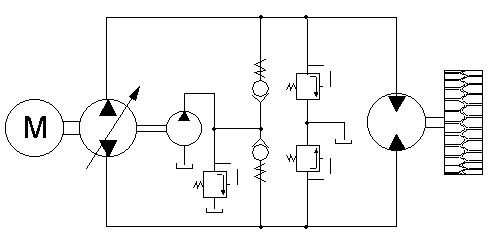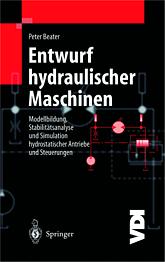




HyLibLite is a subset of
HyLib - Library of Hydraulic Components for Use with Dymola.
The following overview refers to the complete library.
OVERVIEW
========
The hydraulic library contains the most important basic hydraulic components,
in order to model hydraulic circuits. Coupling elements exist to
connect hydraulic components with blocks of the blocks library and elements
of the mechanics library.
The library of hydraulic components supports the following types of models:
1. Modeling of 1-dimensional rotational and translation hydraulic systems.
2. As a state variable the pressure in a lumped volume is used. The inductance
of a moving oil column can be added with the model Inductance.
3. Each component of the main library has a lumped volume connected at each
port. The components can therefore be connected in any sequence.
Note, there are considerable changes with regards to the previous
versions 1.xx of the library of hydraulic components. Therefore read at
least the rules at the end of this information text.
ELEMENTS OF THE LIBRARY
=======================
The library consists of the following elements:
Pumps & Motors
These classes model positive displacement pumps and motors. The shafts of
the pumps and motors can be connected directly to the rotational library.
The control inputs of the variable displacement units can be connected
directly to outputs of the control blocks of the blocks library.
All components have lumped volumes at the inlet and outlet ports.
They also include the inertia of the rotating parts.
Tank Tank with preload pressure and conductance of tank pipe
FlowSource Flow source with internal leakage
FlowSourceExtCommand Flow source with internal leakage
and external command signal
ConPump Constant displacement Pump with leakage
VarPump Variable displacement Pump with leakage
ConMot Constant displacement Motor with leakage
VarMot Variable displacement Motor with leakage
Rotor Inertial of a rotating mass
Diesel Diesel engine with speed controller
Asynchron Asynchron machine
Basic This sublibrary describes ideal pumps and motors,e. g.
without lumped volumes at the ports and without leakage.
IdFLowSource (IFS) Flow source, no input torque required
IdFLowSourceExtCommand (IFE) Flow source, externally commanded flow rate.
IdConPump (IcP) Ideal constant displacement pump
IdVarPump (IvP) Ideal Variable displacement Pump without leakage
IdConMot (IcM) Ideal Constant displacement Motor without leakage
IdVarMot (IVM) Ideal Variable displacement Motor without leakage
TankNoRes (TnR) Tank with preload pressure
Cylinders
These classes model hydraulic cylinders.
All components have lumped volumes at the inlet and outlet
ports and a lumped mass for the piston.
Cylinder1 single acting cylinder
Cylinder2 double acting cylinder
ChamberA oil filled chamber with piston
ChamberB oil filled chamber with piston
Valves
These classes model hydraulic valves.
All valves have lumped volumes at the inlet and outlet ports
CheckValve check valve
CheckValveTwo check valve, different characteristic
ReliefValve relief valve
SerFlowCont serial flow control valve
ReducingValve reducing valve
ShuttleValve shuttle valve
TwoWayValve 2 way valve
ServoValve 4 port servo valve
PropValve 4 port proportional valve
Basic This sublibrary describes valves without lumped volumes at the ports.
CheckValveNoStates (ChknS) check valve
CheckValveTwoNoStates (Ch2nS) check valve, different
ShuttleValveNoStates (ShunS) shuttle valve
ReliefValveNoStates (RelnS) relief valve
ReducingValveNoStates (RednS) reducing valve
TwoWayValveNoStates (TWVnS) 2 way valve SerFlowContNoStates (SFCnS) serial flow control valve
ServoValveNoStates (SeVnS) 4 port servo valve
PropValveNoStates (PrVnS) 4 port proporitional valve
SolenoidL solenoid with PWM
SolenoidR solenoid with PWM
SpoolValve spool valve
Restrictions
These classes model restrictions.
All components have lumped volumes at the inlet and outlet ports.
LamRes Laminar resistance
Orifice Orifice without cavitation (standard model)
OrificePoly Orifice without cavitation, polynomial approach
SimOri Simple Orifice model (text book model)
OriCav Orifice with cavitation
MeteringOri metering orifice (same approach as Orifice)
Basic This sublibrary describes ideal resistances, e. g.
without lumped volumes at the ports.
LamResNoStates (LamnS) Laminar resistance without state variables
OrificeNoStates (OrinS) Orifice without cavitation without state variables
OrificePolyNoStates (OrPnS) Orifice without cavitation, polynomial approach without state variables
OriCavNoStates (OrCnS) Orifice with cavitation without state variables
SimOriNoStates (SOrnS) Simple Orifice model (text book model) without state variables
OrificeNNoStates (OrNnS) orifice model, q given dp computed
MeteringOriNoStates (MOrnS) metering orifice without state variables
TwoOrifices two orifices in series, one fixed, one variable
Sensors
These classes model measurement devices. They are used for control loops
that can be modelled with the blocks library
QMeas sensor for flow measuring
PMeas sensor for pressure measuring
Lines
These classes model long lines and the inertia of a moving oil column.
LongLine Dynamic model of a long line with compressibility,
inductance and frequency dependent viscosity.
RigidLine Losses of a rigid line as a function of Reynolds number
Inductance Theoretical inductance of an oil column
IndHole Inductance of a small hole
Volumes
These classes model the stiffness of hydraulic volumes and accumulators.
OilVolume Lumped volume with pressure dependent compressibilty
(bulk modulus)
VolumeConst lumped volume with constant bulk modulus
VolumeTemp lumped volume with bulk modulus as a function
of pressure and temperature
Accu1 accumulator (simple model)
Accu2 accumulator (more refined model)
Basic This sublibrary describes ideal accumulators without
lumped volumes at the ports.
CONNECTOR VARIABLES
===================
Every library element has one, two or more hydraulic connectors,
where the element can be connected to other library elements.
The following connectors are usually provided:
Connector Port_A ( positive connector, oil entering the component):
---------------------------------------------------------------
Across variable:
port_A.p: Pressure in [Pa] with respect to atmospheric pressure
(p stands for pressure).
Through variables:
port_A.q: Flow rate, positive if oil if entering the component at port A, in [m^3/s]
Connector Port_B ( negative connector, oil leaving the component):
-------------------------------------------------------------
Across variable:
port_B.p: Pressure in [Pa] with respect to atmospheric pressure
(p stands for pressure).
Through variables:
port_B.q: Flow rate, negative if oil if leaving the component at port B, in [m^3/s]
CONNECTION RULES FOR ELEMENTS
=============================
All elements of the main hydraulic library can be connected together in an
almost arbitrary way. As almost every component of the main library has a
lumped volume at each port a model can be build by just connecting the
appropriate library components. The user doesn't have to add lumped volumes
at each node to model the pressure dynamics. Dymola will reduce the index
of the resulting DAE and solve it.
Experienced users can use the additional Basic libraries that can be found
in the main library. These components haven't included lumped volumes at
the ports and therefore the user has to add the required volumes or can
use numerical solution of algebraic equations.
Sign Convention
===============
The following sign convention is used in this library:
If the pressure at port A is greater than the pressure at port B the computed
pressure differential dp is positive and the flow rate at port_A is positive
too. This is the same sign convention as in the mechanics libraries, where a
positive difference between across variable at flange A and across variable
at flange B gives a positive through variable, e. g. flange_a.tau greater
flange_b.tau gives a positive acceleration.
This library has been extensively tested with Dymola 4.1 beta (2000 - 05 - 19)
and the Modelica Standard Library 1.3.2beta (2000 - 05 -16) under Windows NT
and Windows 98.
This library doesn't require the following parts of the Modelica standard library:
Electrical
The reader is cautioned that models contained in this library may not have
been exercised for all cases of interest. While every effort has been made,
within the time available, to ensure that the models are free of
computational and logic errors, they cannot be considered completely
validated. Any application of these models without additional validation
is at the risk of the user.
References

APPENDIX

Release Notes
Version 1.0 (1997 - 7 - 25) Library released
2.0 beta 1 (1999 - 6 - 30) Adapted to Modelica and Dymola 4.0.
Using lumped volumes at each port as default.
Addition of OrificePoly, Line.
2.0 beta 2 (1999 - 8 - 30) Library restructured, using packages.
2.0 beta 3 (1999 - 10 - 5) Connectors changed
2.0 beta 4 (2000 - 1 - 7)
2.0 (2000 - 2 - 23) Tests completed, library released.
2.0 a (2000 - 6 - 2) Small bug fixes.
Copyright (C) 2000, Peter Beater.
The HyLibLight package is free software; it can be redistributed and/or modified under the terms of the Modelica license and the accompanying disclaimer.